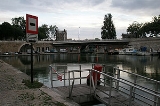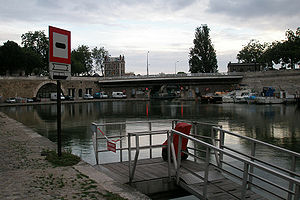
Bassin de l'Arsenal
Encyclopedia
The Bassin de l'Arsenal (also known as the Port de l'Arsenal) is a boat basin in Paris
. It links the Canal Saint-Martin
, which begins at the Place de la Bastille
, to the Seine
, at the Quai de la Rapée. A component of the Réseau des Canaux Parisiens (Parisian Canal Network), it forms part of the borderline between the 12th arrondissement of Paris and the 4th.
From the 16th century until the 19th, an arsenal existed at this location. The arsenal accounts for the name of the basin and the name of the neighborhood, Arsenal, in which the basin lies.
After the widespread destruction during the French Revolution
, the Bassin de l'Arsenal was excavated to replace the ditch that had been in place to draw water from the Seine to fill the moat at the Bastille
fortress. (The Bastille, of course, was destroyed in the events of 14 July 1789 and the days that followed.)
During the nineteenth century and most of the twentieth, the Bassin de l'Arsenal was a commercial port where goods were loaded and unloaded. Separated from the Seine by the Morland lockgate, the port was converted into a leisure port in 1983 by a decision of the Mairie de Paris (Paris City Hall) and the Chamber of Commerce and Industry, and it is now run by the Association for the Leisure Port of Paris-Arsenal.
The basin is part of France's national Voies navigables de France
(VNF, Navigable Waterways of France) system. Since that time, it has been a marina
(in French, a port de plaisance), for approximately 180 pleasure boats.

It is served by lines 1, 5, 7, and 8.




Paris
Paris is the capital and largest city in France, situated on the river Seine, in northern France, at the heart of the Île-de-France region...
. It links the Canal Saint-Martin
Canal Saint-Martin
Canal Saint-Martin is a 4.5 km long canal in Paris. It connects the Canal de l'Ourcq to the river Seine.-Geography:The entrance of the canal is a double lock near Place de Stalingrad. Then, towards the river Seine, the canal is bordered by the quai de Valmy on one side and the quai de Jemmapes on...
, which begins at the Place de la Bastille
Place de la Bastille
The Place de la Bastille is a square in Paris, where the Bastille prison stood until the 'Storming of the Bastille' and its subsequent physical destruction between 14 July 1789 and 14 July 1790 during the French Revolution; no vestige of it remains....
, to the Seine
Seine
The Seine is a -long river and an important commercial waterway within the Paris Basin in the north of France. It rises at Saint-Seine near Dijon in northeastern France in the Langres plateau, flowing through Paris and into the English Channel at Le Havre . It is navigable by ocean-going vessels...
, at the Quai de la Rapée. A component of the Réseau des Canaux Parisiens (Parisian Canal Network), it forms part of the borderline between the 12th arrondissement of Paris and the 4th.
From the 16th century until the 19th, an arsenal existed at this location. The arsenal accounts for the name of the basin and the name of the neighborhood, Arsenal, in which the basin lies.
After the widespread destruction during the French Revolution
French Revolution
The French Revolution , sometimes distinguished as the 'Great French Revolution' , was a period of radical social and political upheaval in France and Europe. The absolute monarchy that had ruled France for centuries collapsed in three years...
, the Bassin de l'Arsenal was excavated to replace the ditch that had been in place to draw water from the Seine to fill the moat at the Bastille
Bastille
The Bastille was a fortress in Paris, known formally as the Bastille Saint-Antoine. It played an important role in the internal conflicts of France and for most of its history was used as a state prison by the kings of France. The Bastille was built in response to the English threat to the city of...
fortress. (The Bastille, of course, was destroyed in the events of 14 July 1789 and the days that followed.)
During the nineteenth century and most of the twentieth, the Bassin de l'Arsenal was a commercial port where goods were loaded and unloaded. Separated from the Seine by the Morland lockgate, the port was converted into a leisure port in 1983 by a decision of the Mairie de Paris (Paris City Hall) and the Chamber of Commerce and Industry, and it is now run by the Association for the Leisure Port of Paris-Arsenal.
The basin is part of France's national Voies navigables de France
Voies navigables de France
is the French navigation authority responsible for the management of the majority of France's inland waterways network and the associated facilities—towpaths, commercial and leisure ports, lock-keeper's houses and other structures. VNF was established in 1991 and took over the responsibility for...
(VNF, Navigable Waterways of France) system. Since that time, it has been a marina
Marina
A marina is a dock or basin with moorings and supplies for yachts and small boats.A marina differs from a port in that a marina does not handle large passenger ships or cargo from freighters....
(in French, a port de plaisance), for approximately 180 pleasure boats.

Metro stations
The Bassin de l'Arsenal is:It is served by lines 1, 5, 7, and 8.




See also
- Bassin de la VilletteBassin de la VilletteThe Bassin de la Villette is the largest artificial lake in Paris. It was filled with water on 2 December 1808. Located in the 19th arrondissement of the capital, it links the Canal de l'Ourcq to the Canal Saint-Martin, and it represents one of the elements of the Réseau des Canaux Parisiens , a...
- Canal de l'OurcqCanal de l'OurcqThe Canal de l'Ourcq is a 108.1 km long canal of the Paris Basin with 10 locks. It was built at a width of 3.2 m but was enlarged to 3.7 m , which permitted use by more pleasure boats...
- Canal Saint-DenisCanal Saint-DenisThe Canal Saint-Denis is a canal in Paris that is in length. The canal connects the Canal de l'Ourcq, at a point north-northwest of the Bassin de la Villette in the 19th arrondissement, with the suburban municipalities of Saint-Denis and Aubervilliers in the department of Seine-Saint-Denis...
- Canal Saint-MartinCanal Saint-MartinCanal Saint-Martin is a 4.5 km long canal in Paris. It connects the Canal de l'Ourcq to the river Seine.-Geography:The entrance of the canal is a double lock near Place de Stalingrad. Then, towards the river Seine, the canal is bordered by the quai de Valmy on one side and the quai de Jemmapes on...
- Place de la BastillePlace de la BastilleThe Place de la Bastille is a square in Paris, where the Bastille prison stood until the 'Storming of the Bastille' and its subsequent physical destruction between 14 July 1789 and 14 July 1790 during the French Revolution; no vestige of it remains....
- Pavillon de l'ArsenalPavillon de l'ArsenalThe Pavillon de l'Arsenal is the Center for information, documentation and exhibition for urban planning and architecture of Paris, a center for urban planning and museum located in the IVe arondissement at 21, boulevard Morland, Paris, France...
: Created in 1988, the Pavillon is a center for information, documentation, and expositions concerning urban planning and architecture. - Caserne des Célestins of the Garde Républicaine: The ceremonial unit of the French Gendarmerie.
- Pont de SullyPont de SullyThe Pont de Sully is a bridge across the River Seine in Paris, France.In reality two separate bridges meeting on the eastern tip of the Île Saint-Louis, it links the 4th and 5th arrondissements of the capital along the line of the Boulevard Henri IV, and connects to the eastern end of the...
: The closest bridge across the Seine. - Square Henri Galli: Contains vestiges of the Bastille fortress.
- Bibliothèque nationale de FranceBibliothèque nationale de FranceThe is the National Library of France, located in Paris. It is intended to be the repository of all that is published in France. The current president of the library is Bruno Racine.-History:...
: An important branch of the great library, one frequented by Victor HugoVictor HugoVictor-Marie Hugo was a Frenchpoet, playwright, novelist, essayist, visual artist, statesman, human rights activist and exponent of the Romantic movement in France....
, is near the boat basin. - Prefecture de Police: Part of the French National Police, which provides the police force for the city of Paris and the surrounding three départements (Hauts-de-Seine, Seine-Saint-Denis, and Val-de-Marne.)
- Opéra BastilleOpéra BastilleL'Opéra Bastille ' is a modern opera house in Paris, France. It is the home base of the Opéra national de Paris and was designed to replace the Palais Garnier, which is nowadays mainly used for ballet performances....
: A modern opera house, it is the home of the Opéra National de Paris. - Quinze-Vingts Hospital: The National Hospital Center for Ophthalmology (CHNO).
- Institut de la Vision (Paris): Associated with the CHNO.
- La PosteLa Poste (France)La Poste is the mail service of France, which also operates postal services in the French Overseas Departments of Réunion, Guadeloupe, Martinique and French Guiana, and the territorial collectivities of Saint Pierre and Miquelon and Mayotte...
: The main post office of Paris is nearby. - Lycée Professionnel Chennevières Malezieux: At 33 Avenue Ledru-Rollin.

